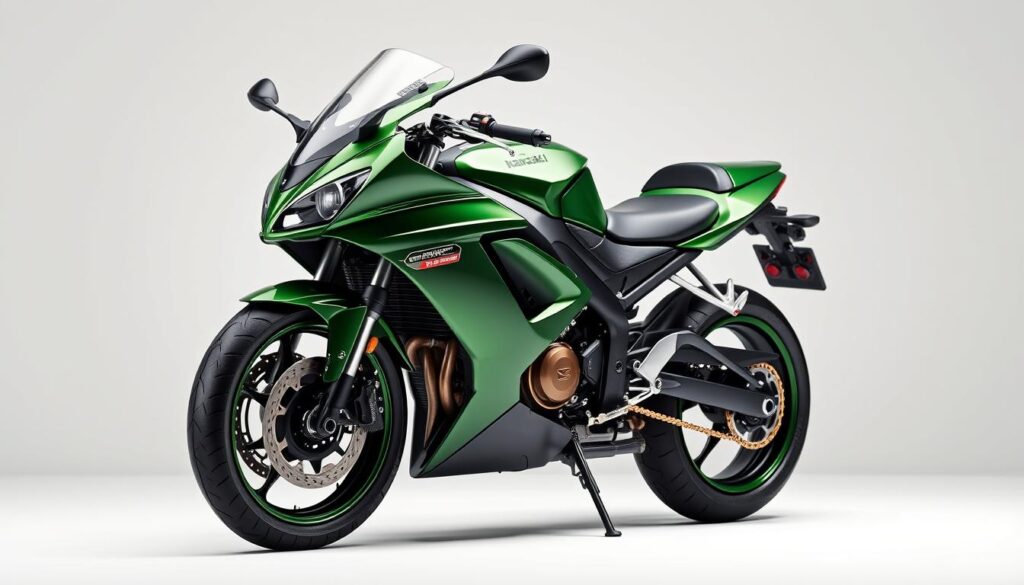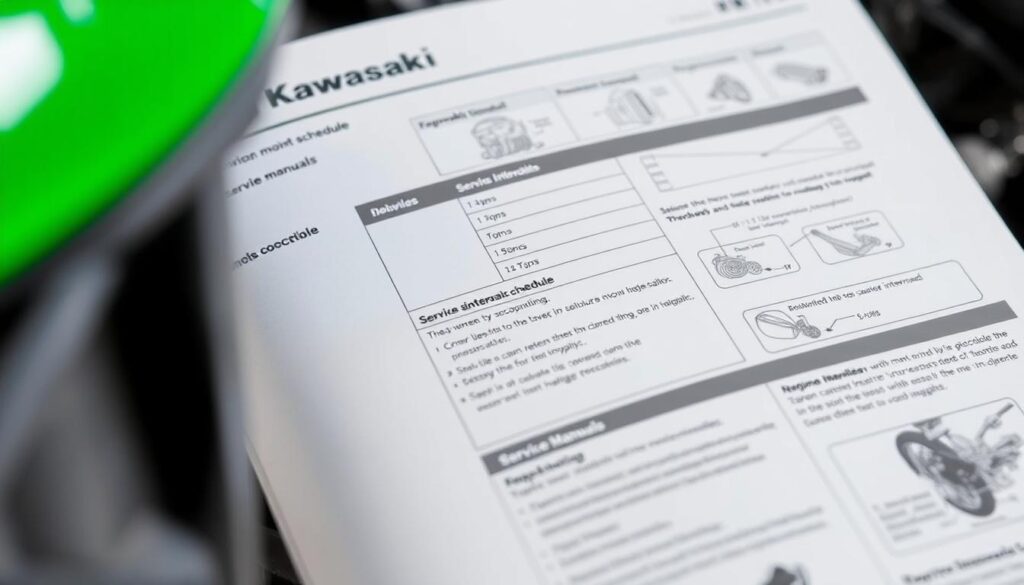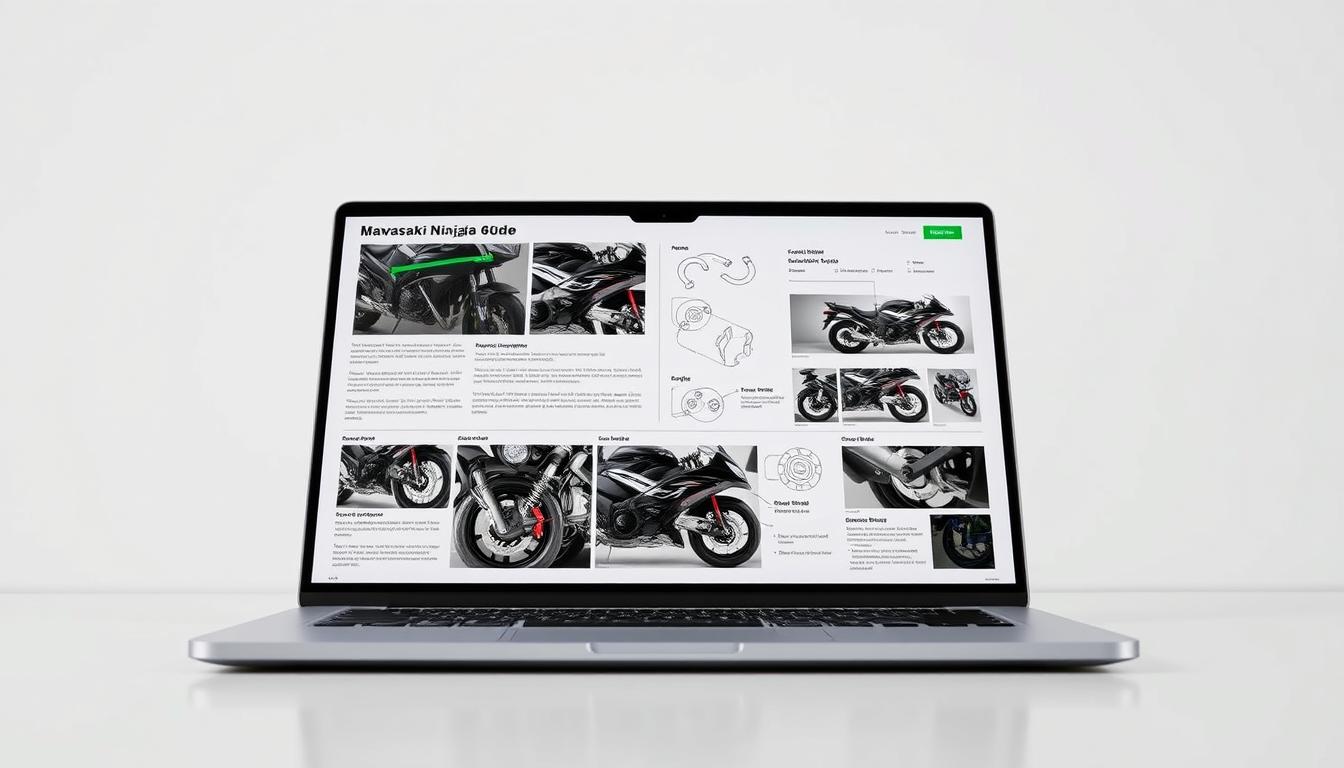The roar of your Kawasaki Ninja 400‘s engine is more than just a sound. It’s a promise of performance and passion. Every sport bike enthusiast knows that true motorcycle mastery goes beyond riding. It’s about understanding and caring for your Kawasaki Ninja 400.
The Kawasaki Ninja 400 is more than just a motorcycle. It has a class-leading 399cc twin-cylinder engine and a lightweight trellis frame. This bike embodies precision engineering. Your commitment to maintenance will unlock its full potential, ensuring every ride is as exhilarating as the first.
This guide isn’t just about routine care. It’s about creating a lasting relationship with your Kawasaki Ninja 400. It transforms maintenance from a chore into an art form. Whether you’re a seasoned rider or new to sport bikes, you’ll discover how to keep your Ninja 400 performing at its peak.
Key Takeaways
- Understand the unique engineering of the Kawasaki Ninja 400
- Learn professional-level maintenance techniques
- Extend the life and performance of your sport bike
- Develop a proactive maintenance mindset
- Save money through preventative care
Understanding Your Kawasaki Ninja 400: Key Specifications
The Kawasaki Ninja 400 is a top pick for new riders. It mixes smart design with easy-to-use power. This makes it great for both beginners and seasoned riders.

Powerful Parallel-Twin Engine
The Ninja 400’s engine is a key feature. Its 399cc parallel-twin engine gives smooth power. This makes riding fun and easy.
- Engine displacement: 399cc
- Horsepower: 49 hp at 10,000 rpm
- Torque: 27 lb-ft at 8,500 rpm
Frame and Construction Insights
The Ninja 400’s frame is lightweight and strong. It makes the bike easy to handle and fun to ride.
| Construction Feature | Performance Benefit |
|---|---|
| Trellis Frame | Enhanced Maneuverability |
| Lightweight Design | Improved Acceleration |
| Compact Geometry | Easier Rider Control |
Performance Characteristics
The Ninja 400 is powerful yet easy to use. Its engine gives smooth power. This helps riders feel confident and enjoy the ride.
“The Ninja 400 transforms entry-level sportbikes into an art form of engineering and excitement.” – Motorcycle Performance Magazine
Whether you’re new or experienced, the Ninja 400 offers a great ride. It balances power with ease of use.
Kawasaki Ninja 400 Maintenance Schedule and Intervals

Keeping your Kawasaki Ninja 400 in top shape is key for its performance and life. A good maintenance plan helps your bike run smoothly and avoids sudden issues.
Here’s a detailed maintenance schedule to keep your Ninja 400 in excellent condition:
- Oil Changes: Every 7,600 miles or annually
- Spark Plug Replacement: Annually or at 7,600-mile intervals
- Air Filter Maintenance: Check and replace as needed
- Valve Clearance Inspection: Every 15,000 miles (24,000 km)
“Regular maintenance is the key to your motorcycle’s long-term performance and reliability.”
Now, let’s look at the important maintenance times for your Kawasaki Ninja 400:
| Maintenance Task | Interval |
|---|---|
| Engine Oil Change | Annually or every 7,600 miles |
| Coolant Replacement | Every 3 years |
| Brake Fluid Replacement | Every 2 years |
| Chain Lubrication | Every 400 miles (600 km) |
Your riding conditions can change the maintenance schedule. Intense track days or harsh environments might need more frequent service. Always check your Kawasaki Ninja 400 owner’s manual for advice based on your model and riding style.
By sticking to these maintenance tips, your Ninja 400 will keep performing well and reliably for many years.
Oil Change and Filter Maintenance for Your Ninja 400
Keeping your Ninja 400cc motorcycle in top shape is all about oil and filter care. This ensures your engine runs smoothly and lasts longer.
Regular oil changes are key for bikes like the Ninja 400. Clean oil keeps your engine running well and prevents damage.
Choosing the Right Oil Type
Choosing the right oil is vital for your Ninja 400cc. Here are the specs to follow:
- Oil Capacity: 2.0L
- Recommended Grade: SAE 10W-40
- Preferred Brands: Kawasaki 10W-40 Engine Oil
- Synthetic vs. Conventional: High-grade synthetic is best
Filter Replacement Guidelines
Oil filter care keeps your engine safe from dirt. Here’s what to do:
- Check the filter with every oil change
- Replace it every 7,600 miles
- Use Kawasaki-recommended oil filters
- Make sure it’s sealed right when you put it back
Oil Change Frequency for High-Performance Riding
| Riding Style | Oil Change Interval |
|---|---|
| Normal Street Riding | Every 7,600 miles or annually |
| Track Days/Aggressive Riding | Every 4,000-5,000 miles |
“Regular maintenance is the key to keeping your Ninja 400cc performing like a champion.” – Professional Motorcycle Technician
Pro tip: Always warm up your engine before changing oil. This helps with better drainage and complete oil replacement.
Fuel System Care and Management for Kawasaki Ninja 400
Keeping your Kawasaki 400cc motorcycle in top shape starts with fuel system care. It’s key to ensure your bike runs smoothly and safely. Regular checks help avoid performance drops and engine harm.
“A well-maintained fuel system is the heartbeat of your motorcycle’s performance.”
Here are the main steps for fuel system care:
- Flush the internal fuel filter every 3,000 miles
- Use top-notch fuel additives
- Keep an eye on fuel system parts
- Look out for contamination signs
Knowing how your Kawasaki Ninja 400’s fuel system works is vital. The Electronic Control Unit (ECU) is crucial for fuel management. A clean system is essential for the ECU to work right.
| Maintenance Task | Frequency | Purpose |
|---|---|---|
| Fuel Filter Flush | Every 3,000 miles | Prevent Engine Contamination |
| Fuel Additive Treatment | Every 1,500 miles | System Cleaning |
| Fuel Quality Check | Monthly | Ensure Optimal Performance |
When picking fuel for your Kawasaki 400cc, go for high-octane gasoline as advised by the maker. Look out for signs like rough idling, less fuel efficiency, or odd engine noises. These could mean your fuel system needs attention.
Pro tip: Always use fuel additives recommended by the manufacturer. This keeps your motorcycle’s fuel system in good shape and prevents long-term damage.
Critical Safety Checks and Brake System Tips for Ninja 400
Keeping your motorcycle’s brakes in top shape is key for safety, especially for new riders like those on the Kawasaki Ninja 400. Your safety gear and brake upkeep are a team effort for a safe ride.
Brake care is more than just looking over them. It’s about knowing the parts that keep you safe while riding.
Brake Pad Inspection and Replacement
It’s important to check your brake pads regularly. Watch out for these signs:
- Visible wear on brake pad surface
- Reduced braking responsiveness
- Unusual squealing or grinding noises
- Brake pad thickness less than 1/4 inch
Brake Fluid Maintenance
Your Ninja 400’s brake fluid is a key safety feature. Bad brake fluid can hurt your stopping power.
- Check brake fluid levels monthly
- Replace fluid every two years
- Use DOT 4 brake fluid recommended by Kawasaki
ABS System Care
The anti-lock brake system (ABS) on your Ninja 400 adds safety. Keeping it in good shape is crucial:
- Perform annual ABS system diagnostic check
- Watch for ABS warning lights
- Keep sensors clean and free from debris
“Safety isn’t expensive, it’s priceless” – Motorcycle Safety Foundation
Spending time on brake maintenance is worth it for every ride. Remember, your safety gear and well-kept brakes are your best defense on the road.
Kawasaki Ninja 400 Chain and Sprocket Maintenance Guide
Keeping your Kawasaki Ninja 400’s chain and sprockets in top shape is key. Sport bikes like the Ninja need careful attention to work well and last long. This ensures they can handle power smoothly and avoid wear.
Chain upkeep includes a few important steps. These steps can greatly affect your bike’s performance:
- Check chain tension regularly
- Lubricate the chain after every ride
- Inspect for wear and alignment
- Replace components when necessary
For Kawasaki bikes, there are specific maintenance times to follow:
| Maintenance Task | Frequency |
|---|---|
| Chain Lubrication | Every 1,000 kilometers |
| Chain Tension Check | Every 500 kilometers |
| Sprocket Inspection | Every 2,000 kilometers |
“Proper chain maintenance can extend your sport bike’s life and prevent costly repairs.”
Here are some technical tips for chain care:
- Aim for chain slack between 2.5 to 3.5 centimeters
- Use a chain lubricant specifically designed for motorcycles
- Avoid aggressive acceleration to reduce chain stress
Pro tip: A 520 chain conversion can potentially reduce unsprung weight and provide performance benefits for your Kawasaki sport bike.
Cooling System and Temperature Management for Ninja 400
Keeping your Kawasaki Ninja 400’s cooling system in top shape is key for its performance and life. The liquid-cooled engine needs careful care to avoid overheating. This is especially true for those looking at a ninja 400 used for sale.
Coolant Level Monitoring
Regular coolant checks are vital for your Ninja 400’s health. Here’s how to do it right:
- Check coolant levels when the engine is cold
- Inspect the transparent reservoir near the radiator
- Keep coolant levels between the minimum and maximum marks
- Use only Kawasaki-recommended coolant
Radiator Maintenance Tips
Your motorcycle’s radiator is key for keeping it cool. Here’s how to keep it clean and working well:
- Clean the radiator fins gently with compressed air
- Remove debris and insects after long rides
- Check for any signs of damage or leaks
- Ensure proper coolant circulation
| Cooling System Parameter | Specification |
|---|---|
| Engine Displacement | 399cc |
| Cooling System Type | Liquid-Cooled |
| Maximum Power | 45 hp at 10,000 rpm |
Temperature Control Solutions
Prevent overheating during high-performance rides with these tips. Proactive maintenance is key to preserving your Ninja 400’s motorcycle performance.
“A well-maintained cooling system ensures your Ninja 400 performs at its best in any riding condition.”
Tire Care and Optimal Pressure for Kawasaki Ninja 400
Proper tire care is key for entry-level sportbikes like the Kawasaki Ninja 400. Your bike’s performance and safety depend on tire care.
“Your tires are the only point of contact between your motorcycle and the road – treat them with respect.”
Understanding tire care involves several key aspects. These aspects directly impact your riding experience:
- Tire pressure impacts handling and safety
- Regular inspection prevents potential accidents
- Proper maintenance extends tire life
Sport tires for entry-level sportbikes use special rubber. This rubber can improve grip by up to 20% during high-speed maneuvers. The Ninja 400’s tire size is 180/55ZR17. This shows the exact width, aspect ratio, and wheel diameter.
| Tire Maintenance Factor | Performance Impact |
|---|---|
| Proper Inflation | Increases tire lifespan by 30-50% |
| Tread Depth | Critical safety indicator |
| Rubber Compound | Enhances grip by up to 20% |
When checking your tires, look at tread depth, wear patterns, and overall condition. Replace tires when tread is below 2/32 of an inch. Tubeless tires are about 10-15% less resistant than traditional tube tires. They’re a great choice for your Ninja 400.
Regular tire maintenance is not just about performance. It’s about keeping you safe on every ride. By following these guidelines, you’ll get the most out of your bike and stay safe on the road.
Conclusion
Keeping your Kawasaki Ninja 400 in top shape is key. It’s not just about regular checks—it’s about keeping a high-performance bike ready for any ride. By following this guide, your bike will stay in great condition, ready for city streets or long highways.
Reviews often praise the Ninja 400 for being easy to start with yet powerful. It has 49 horsepower and can go up to 188 kph. This bike is a great choice for those who take care of it well.
Regular service, oil changes, and inspections are crucial. They help your bike last longer and perform better. The Ninja 400 is more than a bike—it’s a finely tuned machine that loves to be taken care of.
Every maintenance task you do is an investment in your fun on the road. Own your Ninja 400 with confidence. It will keep giving you thrilling rides and reliable travel for years.
FAQ
How often should I change the oil in my Kawasaki Ninja 400?
Change the oil in your Kawasaki Ninja 400 every 4,000 miles or once a year, whichever comes first. If you ride a lot or in harsh conditions, you might need to do it more often. Always check your owner’s manual for the best schedule for your riding.
What type of oil is best for the Ninja 400?
Use a high-quality 10W-40 or 10W-50 motorcycle oil that meets Kawasaki’s standards. Synthetic oils are best for sport bikes like the Ninja 400. Make sure the oil is API-approved and fits your riding conditions.
How do I check and maintain the chain tension on my Ninja 400?
Check the chain tension every 500 miles or before long rides. It should be 1.2-1.4 inches (30-35mm) slack at the midpoint. Use the swingarm markings to guide you. Adjust with the rear axle adjusters and keep the chain clean and lubricated.
What tire pressure should I maintain on the Kawasaki Ninja 400?
For street riding, keep the front tire at 36 PSI and the rear at 42 PSI when cold. These pressures might change based on your ride, load, and tire type. Always check and adjust the pressure before you ride.
How often should I replace the brake pads on my Ninja 400?
Brake pads last between 3,000-5,000 miles, depending on how you ride. Replace them when the friction material is down to 2-3mm. If you hear squealing or feel less braking power, it’s time to check and possibly replace them.
What maintenance is required for the Ninja 400’s cooling system?
Regularly check the coolant level and top it up as needed with Kawasaki’s coolant. Flush the coolant every two years or 12,000 miles. Look for damage or leaks in the radiator and keep the cooling fins clean.
Is the Kawasaki Ninja 400 good for beginners?
Yes, the Ninja 400 is great for beginners. It has the right balance of power, light weight, and sporty feel. The 399cc engine is smooth, making it easy for new riders while still exciting for more experienced ones.
How can I extend the life of my Ninja 400?
Stick to the recommended maintenance schedule, change the oil regularly, and keep the chain well-lubricated and tensioned. Maintain the correct tire pressure and store the bike in a covered area when not in use. Avoid hard riding during the break-in period and warm up the engine before riding aggressively.

